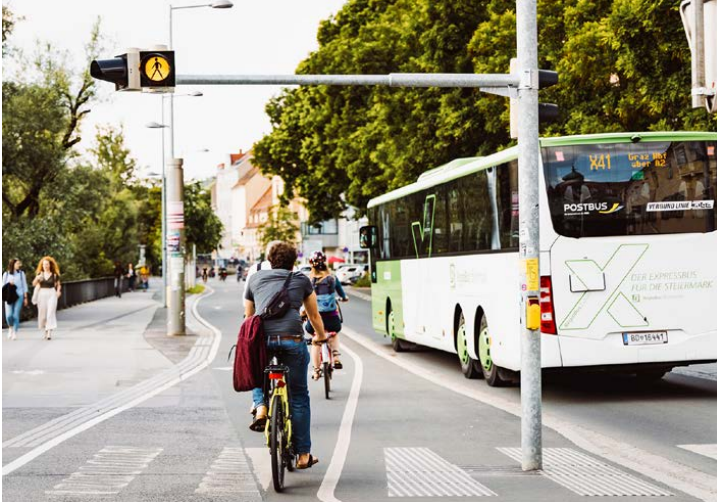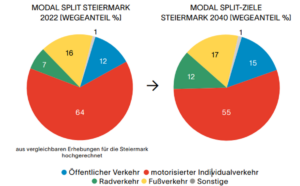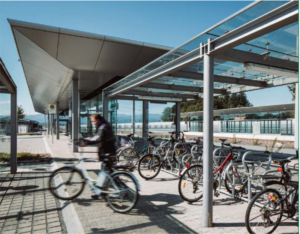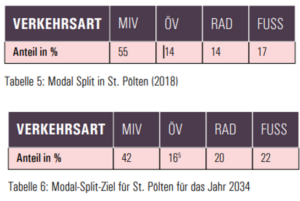New mobility strategies for St. Pölten and Styria

The new mobility strategy Styria 2024+ and the guiding concept for active mobility in St. Pölten were recently published. Both strategies aim to significantly increase cycling in the coming decades. Cycle competence members Rosinak & Partner in Styria and con.sens mobilitätsdesign in St. Pölten were involved. We have summarized the measures planned to increase cycling in the strategies.
Styria: Five percent increase in cycling by 2040
The new Mobility Strategy 2024+ for the federal state of Styria, on which Cycle Competence member Rosinak & Partner worked on behalf of the state government, is here! It replaces the mobility strategy from 2008 and focuses on climate neutrality, quality of life and social participation. The development of the goals was supported by a nationwide online survey of Styrian citizens. This showed that Styrians would like to see an expansion of bus and rail connections as well as modern cycle paths and footpaths.
The comparison of the modal split shows which traffic composition should be achieved in 2040:
An increase of 5 percentage points in cycling is targeted by 2040, i.e. a total of 12% cycling. The share of cycling has already increased, especially in urban centers, and should also be strengthened in the future as a mode of commuting between municipalities.
Increasing active mobility and intermodal routes
In order to achieve this goal, measures have been developed in the thematic block “Increase active modes of mobility” to make cycling mobility more attractive. The Styria 2025 cycling strategy, which is to be further implemented and updated, will be used to promote active mobility. The aim is to implement nationwide cycling concepts and uniform signage and orientation measures. Around half of the 28 planned cycling concepts have already been implemented, with the aim of achieving the greatest possible network effect in the province. Closing gaps, adapting motor vehicle speeds and converting roads to bicycle and school roads are also measures that are intended to make the road network more bicycle-friendly.
The “Increase intermodal routes” thematic block also includes measures for cycling. It is important to increasingly connect transport interfaces such as train and bus stops to the cycle path network. Cycle parking facilities should therefore be evaluated and expanded at such junctions. At more frequented locations, lockable bicycle rooms, bicycle boxes or bicycle garages should offer special protection against the weather and theft. The transportation of bicycles on trains should be made easier by expanding train sets.
Adapt funding models and improve road safety
In order to examine the extent to which the current framework conditions promote active mobility, Styria’s cycling promotion guidelines will be reviewed and adapted to the mobility strategy. More funding is also to be provided for bicycle parking facilities in municipal areas and communal housing. In addition, changes to the funding guidelines, e.g. funding for (e-) transport bikes, folding bikes and other parking facilities, are to be discussed as environmental funding.
The “Road safety” thematic block also contains measures that are specifically intended to increase safety for cyclists. Through high-quality and continuous infrastructure, sufficient visibility for road users, cycling facilities with as few intersections as possible and zones with reduced vehicle speeds, the focus should be on road safety for pedestrians and cyclists. As is well known, the new road traffic regulations include provisions such as an extended overtaking distance for cyclists. Campaigns are intended to raise awareness of such measures.
Guiding concept for active mobility in St. Pölten
The new guiding concept for active mobility for the provincial capital of St. Pölten aims to promote sustainable mobility and quality of life. It was developed in collaboration with Radkompetenz member con.sens mobilitätsdesign. Michael Szeiler, Managing Director of con.sens and project manager of the guiding concept confirms: “The guiding concept for active mobility is the result of an intensive dialog process with citizens, NGOs, the administration and all relevant stakeholders in the city. The task now is to close the most important gaps in the main cycling network as quickly as possible.”
St. Pölten wants 20 percent cycling by 2034
The measures for bicycle traffic are largely taken from the network planning of the basic bicycle network for the municipality. In addition, a participation process was carried out in which ideas were collected online from 2,000 people. The aim of the concept can be seen in the modal split: The cycling mode share should increase to 20% by 2034, i.e. a rise of 6% points in one decade.
Cycle highway and Nextbike expansion flagship project
Three flagship projects in the cycling sector are the expansion of the Wilhelmsburg cycle highway and cycle paths along the Mühlbach and Traisental valleys. The 9 km long Wilhelmsburg cycle highway, one of the cycle highway corridors in Lower Austria, is a long-term project that will be implemented in several stages. It connects the center of the city to the south with the industrial area and outlying villages such as St. Georgen and Ganzendorf. The Traisental cycle path, one of the most important cycle routes in the city, is to be improved in terms of width, surface and accompanying infrastructure.
Left illustration: planned fast cycle route to Wilhelmsburg. Right illustration: Desire for parking facilities
In addition to these three flagship projects, the concept contains packages of measures for cycling that are divided into short (implementation horizon 2027), medium (implementation horizon 2029) and long-term (implementation horizon 2034+). There is a list of over 250 routes and locations that are to be made suitable for cycling.
Another measure is the expansion of the Nextbike system. As of spring 2024, there are 44 Nextbike stations in St. Pölten, mainly in the city center and the Landhaus district. New stations are planned at schools, training centers and important everyday destinations, strategically located along the main cycle routes. This year, the network of stations in the city center and in the northern core of the city will be expanded and individual locations will be equipped with transport bikes. In further steps, the entire city area and surrounding municipalities will be connected to the Nextbike system.
Stations for parking bicycles are also to be expanded. As part of the online participation process, participants were asked where they would like to see more bicycle parking facilities. More and more locations around the city center and the main train station were mentioned, as well as parts of the government district or the Alpenbahnhof, Hammerpark and Traisenpark. This data should provide a basis for the expansion of safe and high-quality cycle parking facilities at these locations.
Further measures include the construction of bicycle playgrounds for learning to cycle through play and a bicycle cab system.
Further links
– Styria 2024+ mobility strategy
– Guiding concept for active mobility in St. Pölten
Graphics and photos: Styria 2024+ mobility strategy and St. Pölten master plan
Cycling Competence Members in this article:
More articles with this member:
[crp]
Share this article:
New mobility strategies for St. Pölten and Styria
Share this article:

The new mobility strategy Styria 2024+ and the guiding concept for active mobility in St. Pölten were recently published. Both strategies aim to significantly increase cycling in the coming decades. Cycle competence members Rosinak & Partner in Styria and con.sens mobilitätsdesign in St. Pölten were involved. We have summarized the measures planned to increase cycling in the strategies.
Styria: Five percent increase in cycling by 2040
The new Mobility Strategy 2024+ for the federal state of Styria, on which Cycle Competence member Rosinak & Partner worked on behalf of the state government, is here! It replaces the mobility strategy from 2008 and focuses on climate neutrality, quality of life and social participation. The development of the goals was supported by a nationwide online survey of Styrian citizens. This showed that Styrians would like to see an expansion of bus and rail connections as well as modern cycle paths and footpaths.
The comparison of the modal split shows which traffic composition should be achieved in 2040:
An increase of 5 percentage points in cycling is targeted by 2040, i.e. a total of 12% cycling. The share of cycling has already increased, especially in urban centers, and should also be strengthened in the future as a mode of commuting between municipalities.
Increasing active mobility and intermodal routes
In order to achieve this goal, measures have been developed in the thematic block “Increase active modes of mobility” to make cycling mobility more attractive. The Styria 2025 cycling strategy, which is to be further implemented and updated, will be used to promote active mobility. The aim is to implement nationwide cycling concepts and uniform signage and orientation measures. Around half of the 28 planned cycling concepts have already been implemented, with the aim of achieving the greatest possible network effect in the province. Closing gaps, adapting motor vehicle speeds and converting roads to bicycle and school roads are also measures that are intended to make the road network more bicycle-friendly.
The “Increase intermodal routes” thematic block also includes measures for cycling. It is important to increasingly connect transport interfaces such as train and bus stops to the cycle path network. Cycle parking facilities should therefore be evaluated and expanded at such junctions. At more frequented locations, lockable bicycle rooms, bicycle boxes or bicycle garages should offer special protection against the weather and theft. The transportation of bicycles on trains should be made easier by expanding train sets.
Adapt funding models and improve road safety
In order to examine the extent to which the current framework conditions promote active mobility, Styria’s cycling promotion guidelines will be reviewed and adapted to the mobility strategy. More funding is also to be provided for bicycle parking facilities in municipal areas and communal housing. In addition, changes to the funding guidelines, e.g. funding for (e-) transport bikes, folding bikes and other parking facilities, are to be discussed as environmental funding.
The “Road safety” thematic block also contains measures that are specifically intended to increase safety for cyclists. Through high-quality and continuous infrastructure, sufficient visibility for road users, cycling facilities with as few intersections as possible and zones with reduced vehicle speeds, the focus should be on road safety for pedestrians and cyclists. As is well known, the new road traffic regulations include provisions such as an extended overtaking distance for cyclists. Campaigns are intended to raise awareness of such measures.
Guiding concept for active mobility in St. Pölten
The new guiding concept for active mobility for the provincial capital of St. Pölten aims to promote sustainable mobility and quality of life. It was developed in collaboration with Radkompetenz member con.sens mobilitätsdesign. Michael Szeiler, Managing Director of con.sens and project manager of the guiding concept confirms: “The guiding concept for active mobility is the result of an intensive dialog process with citizens, NGOs, the administration and all relevant stakeholders in the city. The task now is to close the most important gaps in the main cycling network as quickly as possible.”
St. Pölten wants 20 percent cycling by 2034
The measures for bicycle traffic are largely taken from the network planning of the basic bicycle network for the municipality. In addition, a participation process was carried out in which ideas were collected online from 2,000 people. The aim of the concept can be seen in the modal split: The cycling mode share should increase to 20% by 2034, i.e. a rise of 6% points in one decade.
Cycle highway and Nextbike expansion flagship project
Three flagship projects in the cycling sector are the expansion of the Wilhelmsburg cycle highway and cycle paths along the Mühlbach and Traisental valleys. The 9 km long Wilhelmsburg cycle highway, one of the cycle highway corridors in Lower Austria, is a long-term project that will be implemented in several stages. It connects the center of the city to the south with the industrial area and outlying villages such as St. Georgen and Ganzendorf. The Traisental cycle path, one of the most important cycle routes in the city, is to be improved in terms of width, surface and accompanying infrastructure.
Left illustration: planned fast cycle route to Wilhelmsburg. Right illustration: Desire for parking facilities
In addition to these three flagship projects, the concept contains packages of measures for cycling that are divided into short (implementation horizon 2027), medium (implementation horizon 2029) and long-term (implementation horizon 2034+). There is a list of over 250 routes and locations that are to be made suitable for cycling.
Another measure is the expansion of the Nextbike system. As of spring 2024, there are 44 Nextbike stations in St. Pölten, mainly in the city center and the Landhaus district. New stations are planned at schools, training centers and important everyday destinations, strategically located along the main cycle routes. This year, the network of stations in the city center and in the northern core of the city will be expanded and individual locations will be equipped with transport bikes. In further steps, the entire city area and surrounding municipalities will be connected to the Nextbike system.
Stations for parking bicycles are also to be expanded. As part of the online participation process, participants were asked where they would like to see more bicycle parking facilities. More and more locations around the city center and the main train station were mentioned, as well as parts of the government district or the Alpenbahnhof, Hammerpark and Traisenpark. This data should provide a basis for the expansion of safe and high-quality cycle parking facilities at these locations.
Further measures include the construction of bicycle playgrounds for learning to cycle through play and a bicycle cab system.
Further links
– Styria 2024+ mobility strategy
– Guiding concept for active mobility in St. Pölten
Graphics and photos: Styria 2024+ mobility strategy and St. Pölten master plan
Cycling Competence Members in this article:
More articles with this member:
[crp]





